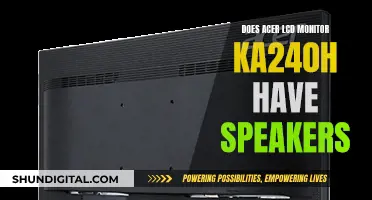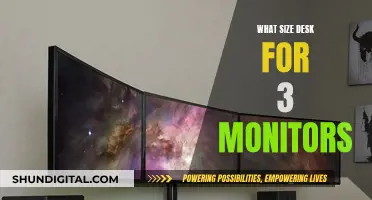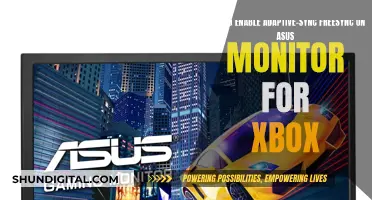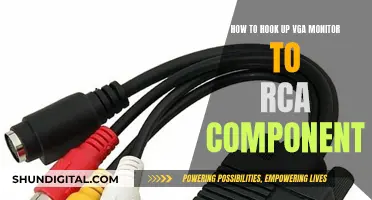
Buying a monitor can be a daunting task, especially if you're not sure what to look for. The first step is to determine your budget and purpose. Are you a gamer, a creative professional, or do you need it for general use? The type of monitor you choose will depend on your specific needs and budget.
For example, if you're a gamer, you'll want a monitor with low latency and a fast response time. If you're a creative professional, colour accuracy and resolution will be important. While for general use, you might opt for a more affordable option with basic features.
Other factors to consider include screen size, resolution, and additional features such as adjustable stands or curved screens. It's also crucial to ensure that the monitor has the right input connections for your computer.
With so many options available, it's important to do your research and read reviews to find the best monitor for your needs.
| Characteristics | Values |
|---|---|
| Budget | $200/£160/AU$300 |
| Purpose | Gaming, business, general use, professional projects |
| Input connection | HDMI, DVI, DisplayPort, USB-C/Thunderbolt 3 |
| Screen size | 27 inches |
| Screen resolution | 4K |
| Aspect ratio | 21:9 |
| Panel type | IPS, VA, TN, OLED, Mini-LED |
| Refresh rate | 144Hz |
| Response time | 5ms |
| Brightness | 250-350 nits |
| Contrast ratio | 1,000:1 |
| Ports | USB, DisplayPort, HDMI |
| Stand | Adjustable height, tilt, swivel, pivot |
What You'll Learn
- Purpose: What you intend to use the monitor for will determine the type of monitor you buy
- Screen resolution: The number of pixels a monitor can display, the higher the resolution, the better the picture
- Features: Monitors with additional features can be more expensive but may be worth it
- Size: The size of the monitor will depend on the space you have available
- Budget: Knowing your budget will help you narrow down your options

Purpose: What you intend to use the monitor for will determine the type of monitor you buy
The purpose for which you intend to use your monitor will determine the type of monitor you buy. For example, if you're a gamer, you'll want a monitor with a fast refresh rate and low response time. If you're a professional, you'll want to prioritise colour accuracy. If you're a general user, you'll likely opt for a monitor with a high-contrast VA panel.
Gaming Monitors
If you're a gamer, you'll want a monitor that can keep up with the speed and intensity of modern games. Look for a monitor with at least Full HD resolution, a response time of 5ms or faster, a refresh rate of 60Hz or faster, and a horizontal viewing angle of 178° or more. Monitors incorporating NVIDIA G-SYNC or AMD FreeSync technology will work with any PC but give you added benefits when paired with a compatible NVIDIA or AMD graphics card.
Professional Monitors
If you're a photographer, print proofer, web designer, special effects artist, or game designer, you'll want a monitor with precise colour control. Look for a monitor that's vendor-certified as colour accurate. You'll also want calibration options, with choices for different colour gamuts, colour temperatures, and gamma curves. Flicker-free monitors are also a good option if you're spending eight hours or more in front of a computer screen.
General Use Monitors
For general use, a monitor with a VA panel will give you the best contrast and colour reproduction. If you're staring at the screen for over eight hours a day, a flicker-free monitor will be easier on your eyes. Low blue light is also a nice feature, although it's not necessary as most operating systems have modes for reducing blue light.
How Dual Monitors Affect Disk Usage Performance
You may want to see also

Screen resolution: The number of pixels a monitor can display, the higher the resolution, the better the picture
When it comes to screen resolution, the general rule is that the higher the resolution, the better the picture. Screen resolution refers to the number of pixels a monitor can display, and is usually given as a horizontal and vertical measurement, for example, 1024 x 768. The higher the number of pixels, the finer the details of the picture will be.
For graphic design or 3D modelling, a resolution of 1360 x 768 is the minimum, but 1920 x 1080 is more ideal. For complex 3D designs or video editing, a resolution of 1920 x 1080 (HD) is recommended, while photographers should opt for the highest resolution they can afford.
A 4K display (3840 x 2160) will always look better than a 1920 x 1080 Full HD display and is more future-proof. As 4K screens become more affordable, there is little reason not to opt for the higher resolution if your budget allows.
If you are working with multiple applications at once, an ultrawide monitor with a resolution of up to 5120 x 1440 (or a 32:9 aspect ratio) could be a good option, providing plenty of screen real estate. However, ultrawide monitors are generally more expensive than their flat-screen counterparts and require more space on your desk.
OptiPlex 7070 Micro: Hooking Up Your Monitor
You may want to see also

Features: Monitors with additional features can be more expensive but may be worth it
When it comes to monitors, additional features can make a huge difference to your experience, and they are worth considering even if they stretch your budget.
One of the most important features to look out for is the monitor's design. A bezel-less design is sleek and provides more screen space. But more importantly, you should look for ergonomic features like an adjustable arm that allows you to fix the height, tilt, and swivel. This can help reduce desk clutter and provide a more comfortable viewing experience. Some monitors even have rotating displays that can be used in portrait mode, which can be useful for certain tasks like editing portraits or viewing long web pages.
Another feature to consider is the screen type. Curved screens can provide a more uniform colour experience and help reduce eye strain, but they tend to be more expensive and may not be ideal if you're working with a lot of straight lines. If you're a gamer, you might also want to consider a monitor with a high refresh rate and fast response time to reduce motion blur and provide a smoother experience.
If you're a creative professional, colour accuracy is extremely important. Look for a monitor with precise colour, contrast, and temperature controls, and consider investing in a pre-calibrated professional monitor to ensure optimum colour accuracy. Additionally, you may want to look for a monitor with multiple ports for USB, DisplayPort, and HDMI connectivity, which can be useful if you use multiscreen setups or plug in peripherals like drawing tablets.
Finally, consider the extra features that can make your life easier. Built-in speakers, webcams, and USB hubs can be convenient, and some monitors even have Qi wireless charging pads built into the base. If you're short on desk space, these additional features can be a great way to consolidate multiple devices into one.
Where to Find Your ASUS Monitor Model Number
You may want to see also

Size: The size of the monitor will depend on the space you have available
When it comes to the size of your monitor, it's important to consider the space you have available. You'll want to ensure that your monitor fits comfortably within the width of your desk, with enough room for other items like peripherals, paperwork, and personal effects. If you're planning to use a dual-monitor setup, you'll need to account for the additional space required.
It's also crucial to think about how far you'll be sitting from the monitor. For larger screens, typically those above 20 inches, it's recommended to sit more than an arm's length away. This allows you to view the screen comfortably without having to lean forward or squint. Alternatively, you can opt for a monitor arm, which lets you adjust the distance of the monitor as needed and helps keep your desk clutter-free.
In terms of specific sizes, monitors generally range from 15 inches up to 30 inches when measured diagonally. Ultrawide monitors can go up to 50 inches. For creatives such as graphic designers, digital illustrators, and photographers, a monitor between 27 and 32 inches is usually sufficient. Only consider going larger if you frequently edit multiple projects simultaneously or engage in heavy multitasking.
While bigger screens offer more display space, it's important not to go overboard. You don't want the monitor to dominate your desk or hinder your productivity. Additionally, the size of the monitor should align with your budget, as larger screens tend to be more expensive.
When deciding on the size, it's worth considering the resolution as well. A higher resolution on a smaller screen can provide a sharper image. For example, a 24-inch monitor with 1080p resolution or a 27-inch monitor with 1440p resolution are often recommended.
Direct Wiring Method: LCD Monitor and Transformer Connection
You may want to see also

Budget: Knowing your budget will help you narrow down your options
Budgeting is a crucial aspect of buying a monitor, as it will help you narrow down your options and make an informed purchase decision. Here are some tips to consider when it comes to budgeting for a new monitor:
Determine Your Price Range: Before you start shopping, decide on a realistic budget that you are comfortable with. Monitors can range from a few hundred to a few thousand dollars, so knowing your price range will help you focus on the options within your reach.
Prioritize Features: Different monitors offer various features such as resolution, refresh rate, response time, panel type, connectivity options, and more. Identify the features that are most important to you and be willing to compromise on others to stay within your budget. For example, if you are a gamer, you may prioritize a high refresh rate and low response time over other features.
Compare Prices: Don't just settle for the first monitor you find within your budget. Take the time to compare prices from different retailers or wait for sales and promotions to get the best value for your money. Monitor prices can fluctuate, so keeping an eye on pricing trends can help you snag a good deal.
Consider Your Usage: Think about how you will primarily use your monitor. If it's for general-purpose use, you may not need all the bells and whistles of a high-end gaming or professional monitor. On the other hand, if you're a creative professional or an avid gamer, investing in a monitor with the right specifications will be worth it, even if it stretches your budget a bit.
Balance Quality and Cost: While it's important to stay within your budget, remember that quality is also crucial. A cheap monitor may save you money upfront but could lack the performance, features, or durability of a slightly more expensive option. Striking a balance between price and quality will ensure you get the best value for your money.
By following these tips and knowing your budget, you'll be well on your way to finding the right monitor that suits your needs and financial constraints.
Daisy Chaining ASUS Monitors: The Ultimate Guide
You may want to see also
Frequently asked questions
The ideal screen size depends on your usage and the space you have available. For example, if you're looking for a generic display for working or schooling, a 27-inch flat-screen display is recommended. If you need to save some money, you can go for a 24-inch model, which is also a good choice if you're short on space. For gamers and creative professionals, larger screens are often preferred, with sizes ranging from 27 to 32 inches being common.
The resolution you choose depends on the screen size and your intended use. For a 27-inch display, a resolution of 1920x1080 (Full HD) is recommended, while for a 24-inch display, this resolution may appear stretched. If you're looking for a higher resolution, 4K (3840x2160) is a good option and is ideal for gamers, graphics professionals, and movie fans who want to see fine details. Keep in mind that your computer's graphics card should also support the chosen resolution.
There are several types of panel technologies available, including TN (Twisted Nematic), VA (Vertical Alignment), and IPS (In-Plane Switching). TN panels are typically the cheapest option and offer fast refresh rates, making them popular among gamers. However, they may have limited colour accuracy and viewing angles. VA panels offer better contrast and image depth but are still relatively affordable. IPS panels provide consistent colour accuracy and wide viewing angles, making them ideal for photographers, graphic designers, and other professionals.







